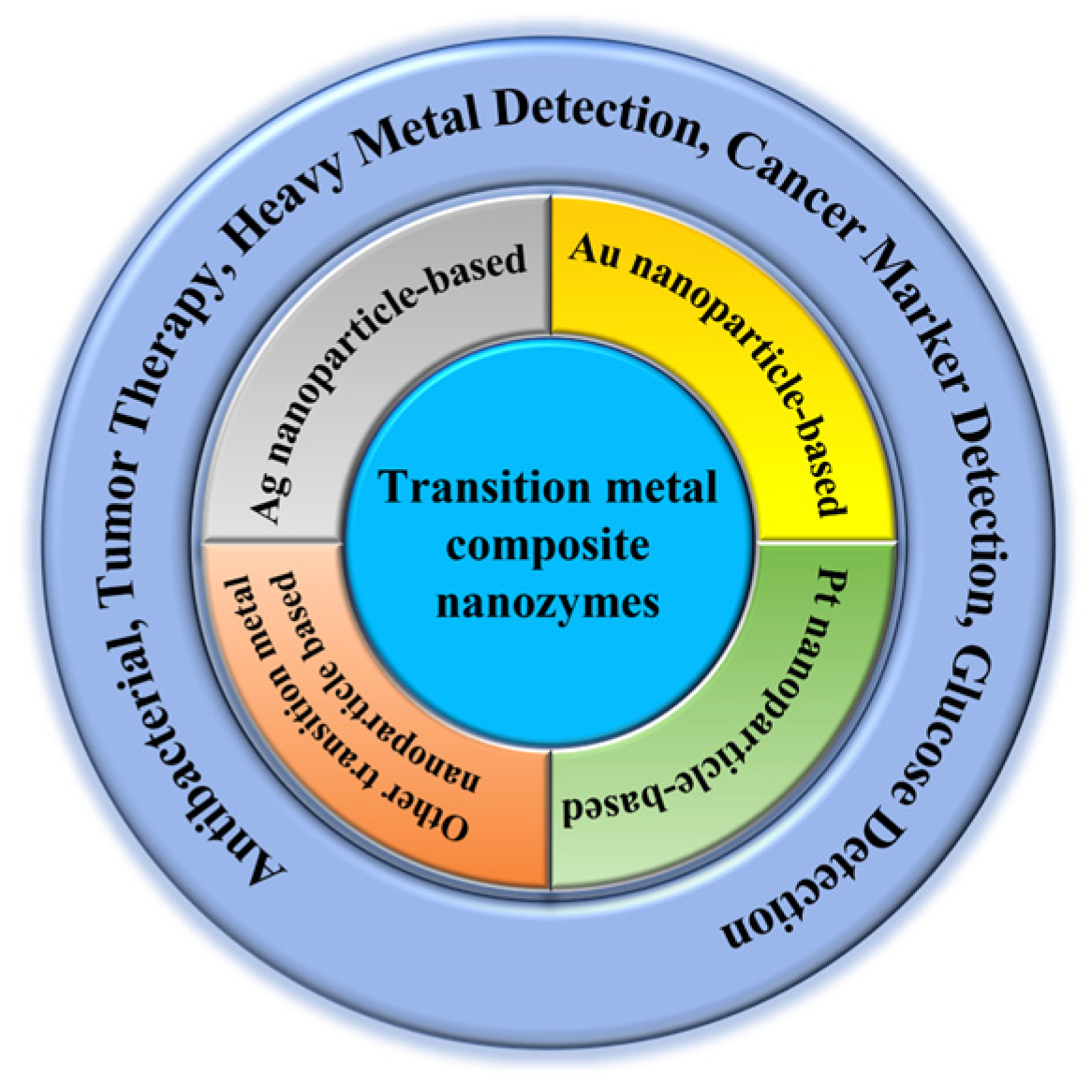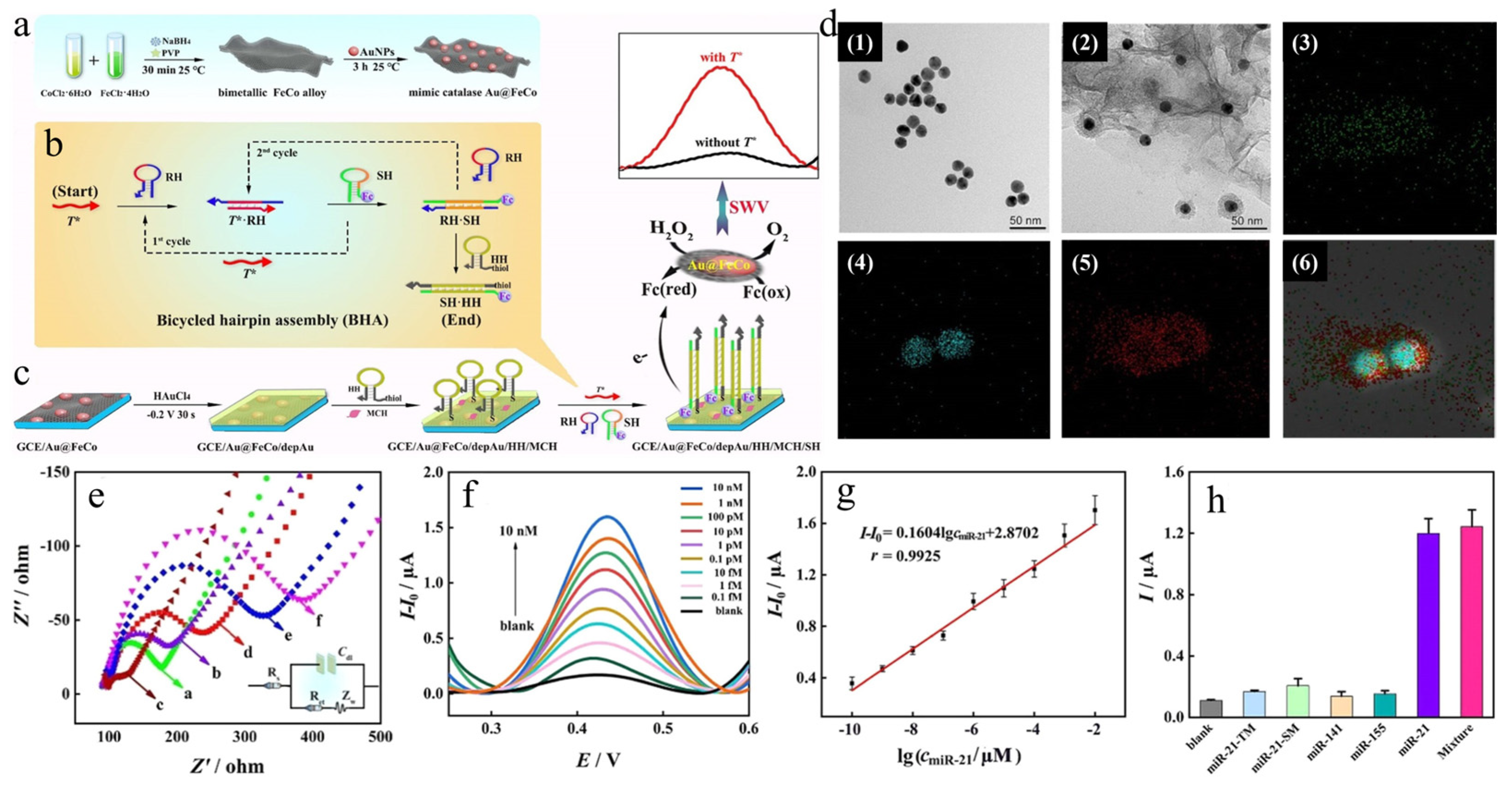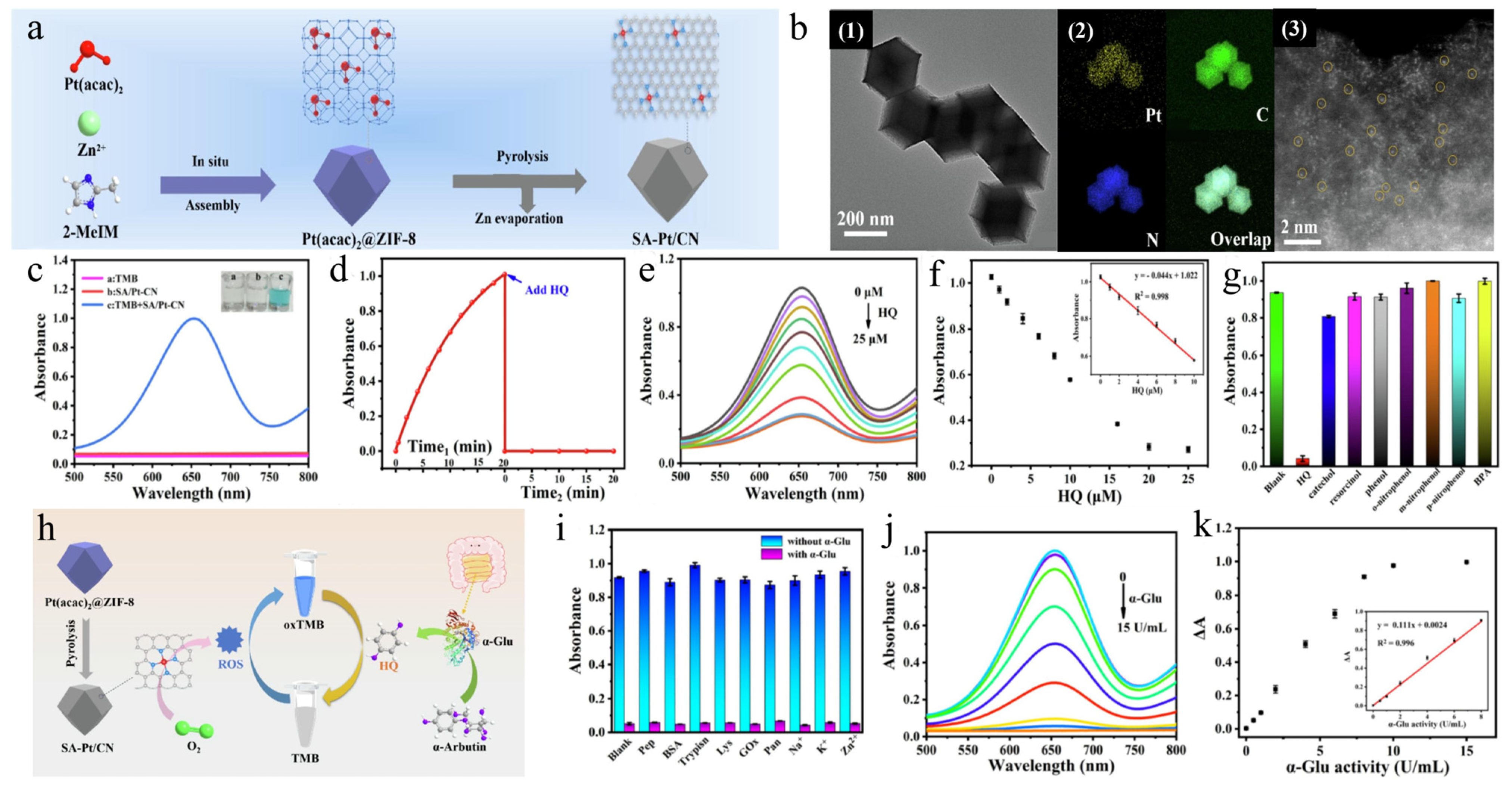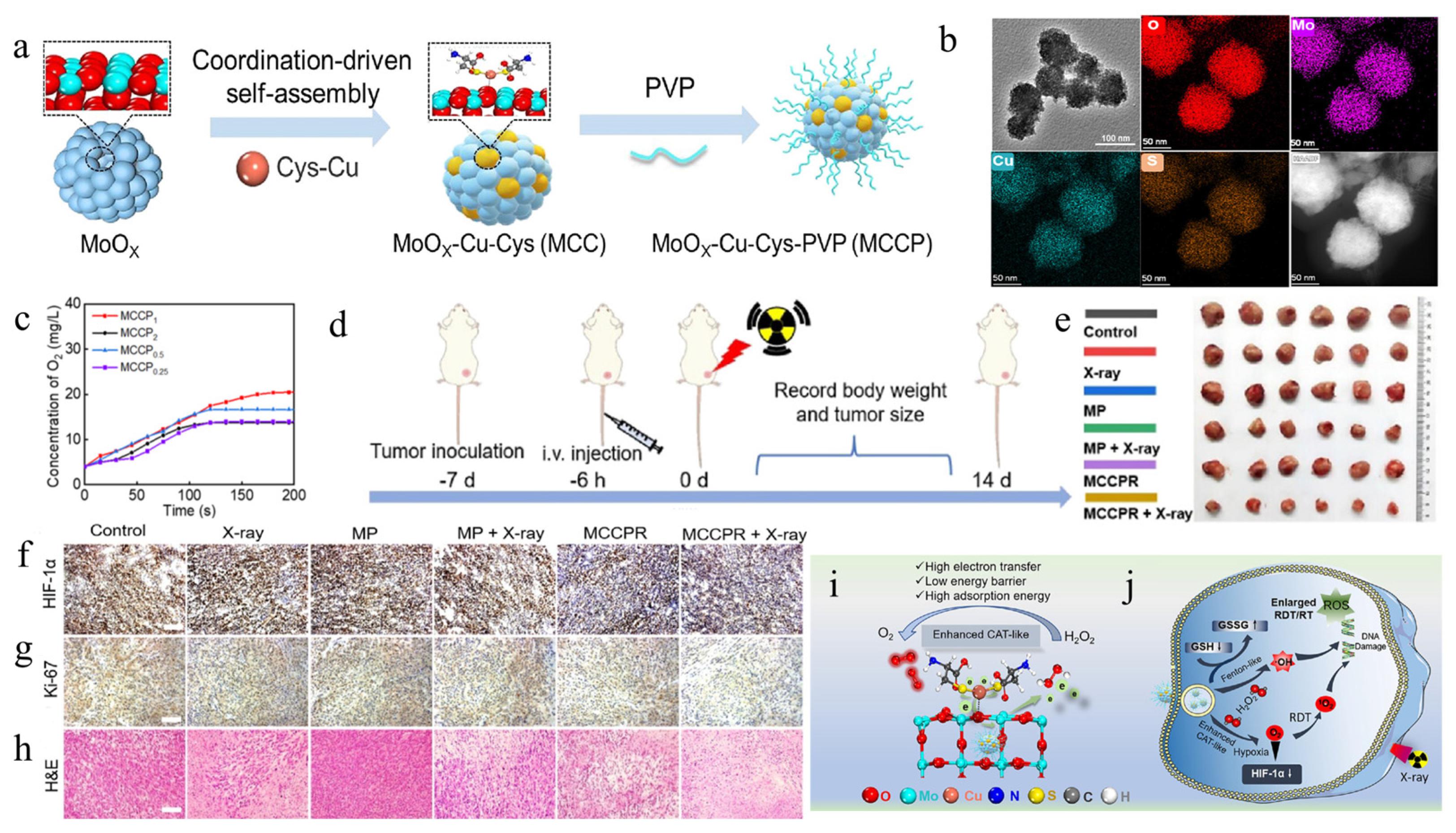Advances in the Application of Transition-Metal Composite Nanozymes in the Field of Biomedicine
Abstract
:1. Introduction
2. Ag Nanoparticle-Based Composite Nanozymes
2.1. Ag-Based Composite Nanozymes in Disease Diagnosis
2.2. Ag-Based Composite Nanozymes for Antimicrobial Applications
2.3. Ag-Based Composite Nanozymes for Glucose Testing
3. Au Nanoparticle-Based Composite Nanozymes
3.1. Au-Based Composite Nanozymes for Antimicrobial Applications
3.2. Au-Based Composite Nanozymes in Glucose Detection and Cancer Cell Detection
3.3. Au-Based Composite Nanozymes as a Possible Way Forward
4. Pt Nanoparticle-Based Composite Nanozymes
4.1. Pt-Based Composite Nanozymes for Antibacterial Applications
4.2. Application of Pt-Based Composite Nanozymes for Glucose and α-Glucosidase Detection
4.3. Pt-Based Composite Nanozymes for Tumor Cell Inactivation and Mercury Ion Detection
5. Other Transition-Metal-Nanoparticle-Based Composite Nanozymes
5.1. Advances in Other Transition-Metal Composite Nanozymes for Tumor/Cancer Cell Applications
5.2. Other Transition-Metal Composite Nanozymes in Other Applications
6. Conclusions
Author Contributions
Funding
Institutional Review Board Statement
Informed Consent Statement
Data Availability Statement
Conflicts of Interest
References
- Gulcin, I.; Taslimi, P.; Aygun, A.; Sadeghian, N.; Bastem, E.; Kufrevioglu, O.I.; Turkan, F.; Sen, F. Antidiabetic and antiparasitic potentials: Inhibition effects of some natural antioxidant compounds on alpha-glycosidase, alpha-amylase and human glutathione S-transferase enzymes. Int. J. Biol. Macromol. 2018, 119, 741–746. [Google Scholar] [CrossRef] [PubMed]
- Zou, Y.; Li, H.; Graham, E.T.; Deik, A.A.; Eaton, J.K.; Wang, W.; Sandoval-Gomez, G.; Clish, C.B.; Doench, J.G.; Schreiber, S.L. Cytochrome P450 oxidoreductase contributes tophospholipid peroxidation in ferroptosis. Nat. Chem. Biol. 2020, 16, 302–309. [Google Scholar] [CrossRef]
- Song, Z.; Cai, Y.; Lao, X.; Wang, X.; Lin, X.; Cui, Y.; Kalavagunta, P.K.; Liao, J.; Jin, L.; Shang, J.; et al. Taxonomic profiling and populational patterns of bacterial bile salt hydrolase (BSH) genes based on worldwide human gut microbiome. Microbiome 2019, 7, 9. [Google Scholar] [CrossRef] [PubMed]
- Paul, B.D.; Sbodio, J.I.; Xu, R.; Vandiver, M.S.; Cha, J.Y.; Snowman, A.M.; Snyder, S.H. Cystathionine γ-Lyase deficiency mediates neurodegeneration in huntington’s disease. Nature 2014, 509, 96–100. [Google Scholar] [CrossRef]
- Fu, M.; Zhang, W.; Wu, L.; Yang, G.; Li, H.; Wang, R. Hydrogen sulfide (H2S) metabolism in mitochondria and its regulatory role in energy production. Proc. Natl. Acad. Sci. USA 2012, 109, 2943–2948. [Google Scholar] [CrossRef] [PubMed]
- Liu, Z.; Pan, Q.; Ding, S.; Qian, J.; Xu, F.; Zhou, J.; Cen, S.; Guo, F.; Liang, C. The interferon-inducible MxB protein inhibits HIV-1 infection. Cell Host Microbe 2013, 14, 398–410. [Google Scholar] [CrossRef] [PubMed]
- Nguyen, G.K.T.; Wang, S.; Qiu, Y.; Hemu, X.; Lian, Y.; Tam, J.P. Butelase 1 is an Asx-specific ligase enabling peptide macrocyclization and synthesis. Nat. Chem. Biol. 2014, 10, 732–738. [Google Scholar] [CrossRef]
- Zhang, S.; Zhao, W.; Zeng, J.; He, Z.; Wang, X.; Zhu, Z.; Hu, R.; Liu, C.; Wang, Q. Wearable non-invasive glucose sensors based on metallic nanomaterials. Mater. Today Bio 2023, 20, 100638. [Google Scholar] [CrossRef]
- Nasrollahzadeh, M.; Sajjadi, M.; Iravani, S.; Varma, R.S. Carbon-based sustainable nanomaterials for water treatment: State-of-art and future perspectives. Chemosphere 2021, 263, 128005. [Google Scholar] [CrossRef]
- Liu, X.; Zhao, Y.; Xu, Y.; Liu, C. Synthesis of gamma-cyclodextrin-reduced Fe(III) nanoparticles with peroxidase-like catalytic activity for bacteriostasis of food. Nano Lett. 2023, 23, 9995–10003. [Google Scholar] [CrossRef]
- Liang, M.; Yan, X. Nanozymes: From new concepts, mechanisms, and standards to applications. Acc. Chem. Res. 2019, 52, 2190–2200. [Google Scholar] [CrossRef]
- Wu, F.; Chen, H.; Liu, R.; Suo, Y.; Li, Q.; Zhang, Y.; Liu, H.; Cheng, Z.; Chang, Y. Modulation of the tumor immune microenvironment by Bi2Te3-Au/Pd-Based theranostic nanocatalysts enables efficient cancer therapy. Adv. Healthc. Mater. 2022, 11, e2200809. [Google Scholar] [CrossRef] [PubMed]
- Ding, Y.; Wang, Z.; Zhang, Z.; Zhao, Y.; Yang, S.; Zhang, Y.; Yao, S.; Wang, S.; Huang, T.; Zhang, Y.; et al. Oxygen vacancy-engineered BaTiO3 nanoparticles for synergistic cancer photothermal, photodynamic, and catalytic therapy. Nano Res. 2022, 15, 7304–7312. [Google Scholar] [CrossRef]
- Zhang, Y.; Wang, F.; Liu, C.; Wang, Z.; Kang, L.; Huang, Y.; Dong, K.; Ren, J.; Qu, X. Nanozyme decorated metal-organic frameworks for enhanced photodynamic therapy. ACS Nano 2018, 12, 651–661. [Google Scholar] [CrossRef]
- Jiao, L.; Wu, J.; Zhong, H.; Zhang, Y.; Xu, W.; Wu, Y.; Chen, Y.; Yan, H.; Zhang, Q.; Gu, W.; et al. Densely isolated FeN4 sites for peroxidase mimicking. ACS Catal. 2020, 10, 6422–6429. [Google Scholar] [CrossRef]
- Sharifi, M.; Hosseinali, S.H.; Yousefvand, P.; Salihi, A.; Shekha, M.S.; Aziz, F.M.; JouyaTalaei, A.; Hasan, A.; Falahati, M. Gold nanozyme: Biosensing and therapeutic activities. Mater. Sci. Eng. C Mater. Biol. Appl. 2020, 108, 110422. [Google Scholar] [CrossRef] [PubMed]
- Liu, C.; Xing, J.; Akakuru, O.U.; Luo, L.; Sun, S.; Zou, R.; Yu, Z.; Fang, Q.; Wu, A. Nanozymes-engineered metal–organic frameworks for catalytic cascades-enhanced synergistic cancer therapy. Nano Lett. 2019, 19, 5674–5682. [Google Scholar] [CrossRef] [PubMed]
- Ou, D.; Sun, D.; Lin, X.; Liang, Z.; Zhong, Y.; Chen, Z. A dual-aptamer-based biosensor for specific detection of breast cancer biomarker HER2 via flower-like nanozymes and DNA nanostructures. J. Mater. Chem. B 2019, 7, 3661–3669. [Google Scholar] [CrossRef]
- Hai, X.; Li, Y.; Yu, K.; Yue, S.; Li, Y.; Song, W.; Bi, S.; Zhang, X. Synergistic in-situ growth of silver nanoparticles with nanozyme activity for dual-mode biosensing and cancer theranostics. Chin. Chem. Lett. 2021, 32, 1215–1219. [Google Scholar] [CrossRef]
- Cao, J.; Sun, Q.; Shen, A.-G.; Fan, B.; Hu, J.-M. Nano Au@Cu2−xS with near-infrared photothermal and peroxidase catalytic activities redefines efficient antibiofilm-oriented root canal therapy. Chem. Eng. J. 2021, 422, 130090. [Google Scholar] [CrossRef]
- Gao, L.; Zhuang, J.; Nie, L.; Zhang, J.; Zhang, Y.; Gu, N.; Wang, T.; Feng, J.; Yang, D.; Perrett, S.; et al. Intrinsic peroxidase-like activity of ferromagnetic nanoparticles. Nat. Nanotechnol. 2007, 2, 577–583. [Google Scholar] [CrossRef] [PubMed]
- Zhu, X.; Song, P.; Hou, S.; Zhao, H.; Gao, Y.; Wu, T.; Liu, Q. Synthesis of Ag nanoparticles supported on magnetic halloysite nanozyme for detection of H2O2 in milk and serum. Appl. Clay Sci. 2023, 242, 107022. [Google Scholar] [CrossRef]
- Liu, Q.; Wang, H.; Yang, Q.; Tong, Y.; He, W. Metal–organic frameworks loaded Au nanozymes with enhanced peroxidase-like activity for multi-targeted biodetection. Mater. Adv. 2022, 3, 8557–8566. [Google Scholar] [CrossRef]
- Xing, G.; Shang, Y.; Ai, J.; Lin, H.; Wu, Z.; Zhang, Q.; Lin, J.-M.; Pu, Q.; Lin, L. Nanozyme-mediated catalytic signal amplification for microfluidic biosensing of foodborne bacteria. Anal. Chem. 2023, 95, 13391–13399. [Google Scholar] [CrossRef] [PubMed]
- Li, J.; Wang, H.; Liu, M.; Qin, Y.; Tan, R.; Hu, L.; Gu, W.; Zhu, C. Galvanic replacement reaction-regulated photoelectric response and enzyme-mimicking property of ionic liquid functionalized Cu@Cu2O aerogels for dual-mode immunoassay. Chem. Eng. J. 2023, 455, 140743. [Google Scholar] [CrossRef]
- Lin, S.; Gregory, R.I. MicroRNA biogenesis pathways in cancer. Nat. Rev. Cancer 2015, 15, 321–333. [Google Scholar] [CrossRef]
- Shen, B.; Wu, Q.; Fan, Y.; Wu, H.; Li, X.; Zhao, X.; Wang, Y.; Ding, S.; Zhang, J. TiO2@Ag nanozyme enhanced electrochemiluminescent biosensor coupled with DNA nanoframework-carried emitters and enzyme-assisted target recycling amplification for ultrasensitive detection of microRNA. Chem. Eng. J. 2022, 445, 136820. [Google Scholar] [CrossRef]
- Lin, J.; Lee, I.M.; Song, Y.; Cook, N.R.; Selhub, J.; Manson, J.E.; Buring, J.E.; Zhang, S.M. Plasma homocysteine and cysteine and risk of breast cancer in women. Cancer Res. 2010, 70, 2397–2405. [Google Scholar] [CrossRef]
- Mazhani, M.; Alula, M.T.; Murape, D. Development of a cysteine sensor based on the peroxidase-like activity of AgNPs@ Fe3O4 core-shell nanostructures. Anal. Chim. Acta 2020, 1107, 193–202. [Google Scholar] [CrossRef]
- Cao, C.; Zhang, T.; Yang, N.; Niu, X.; Zhou, Z.; Wang, J.; Yang, D.; Chen, P.; Zhong, L.; Dong, X.; et al. POD Nanozyme optimized by charge separation engineering for light/pH activated bacteria catalytic/photodynamic therapy. Signal Transduct. Target. Ther. 2022, 7, 86. [Google Scholar] [CrossRef]
- Zhang, W.; Ren, X.; Shi, S.; Li, M.; Liu, L.; Han, X.; Zhu, W.; Yue, T.; Sun, J.; Wang, J. Ionic silver-infused peroxidase-like metal–organic frameworks as versatile “antibiotic” for enhanced bacterial elimination. Nanoscale 2020, 12, 16330–16338. [Google Scholar] [CrossRef] [PubMed]
- Guo, Y.; Wang, H.; Ma, X.; Jin, J.; Ji, W.; Wang, X.; Song, W.; Zhao, B.; He, C. Fabrication of Ag-Cu2O/reduced graphene oxide nanocomposites as surface-enhanced raman scattering substrates for in situ monitoring of peroxidase-like catalytic reaction and biosensing. ACS Appl. Mater. Interfaces 2017, 9, 19074–19081. [Google Scholar] [CrossRef] [PubMed]
- Cheng, X.; Sun, R.; Yin, L.; Chai, Z.; Shi, H.; Gao, M. Light-triggered assembly of gold nanoparticles for photothermal therapy and photoacoustic imaging of tumors in vivo. Adv. Mater. 2017, 29, 1604894. [Google Scholar] [CrossRef] [PubMed]
- Lin, G.; Xian, L.; Zhou, X.; Wang, S.; Shah, Z.H.; Edwards, S.A.; Gao, Y. Design and one-pot synthesis of capsid-like gold colloids with tunable surface roughness and their enhanced sensing and catalytic performances. ACS Appl. Mater. Interfaces 2020, 12, 50152–50160. [Google Scholar] [CrossRef]
- Dhakshinamoorthy, A.; Asiri, A.M.; Garcia, H. Metal organic frameworks as versatile hosts of au nanoparticles in heterogeneous catalysis. ACS Catal. 2017, 7, 2896–2919. [Google Scholar] [CrossRef]
- Ribeiro, J.S.; Daghrery, A.; Dubey, N.; Li, C.; Mei, L.; Fenno, J.C.; Schwendeman, A.; Aytac, Z.; Bottino, M.C. Hybrid antimicrobial hydrogel as injectable therapeutics for oral infection ablation. Biomacromolecules 2020, 21, 3945–3956. [Google Scholar] [CrossRef]
- Cao, M.; Chang, Z.; Tan, J.; Wang, X.; Zhang, P.; Lin, S.; Liu, J.; Li, A. Superoxide radical-mediated self-synthesized Au/MOO3-x hybrids with enhanced peroxidase-like activity and photothermal effect for anti-mrsa therapy. ACS Appl. Mater. Interfaces 2022, 14, 13025–13037. [Google Scholar] [CrossRef]
- Li, Y.; Fu, R.; Duan, Z.; Zhu, C.; Fan, D. Injectable hydrogel based on defect-rich multi-nanozymes for diabetic wound healing via an oxygen self-supplying cascade reaction. Small 2022, 18, e2200165. [Google Scholar] [CrossRef]
- Cai, S.; Fu, Z.; Xiao, W.; Xiong, Y.; Wang, C.; Yang, R. Zero-dimensional/two-dimensional AuxPd100−x nanocomposites with enhanced nanozyme catalysis for sensitive glucose detection. ACS Appl. Mater. Interfaces 2020, 12, 11616–11624. [Google Scholar] [CrossRef]
- Huang, W.; Yang, C.; Gao, J.; Ye, J.; Yuan, R.; Xu, W. Cooperative amplification of Au@FeCo as mimetic catalytic nanozymes and bicycled hairpin assembly for ultrasensitive electrochemical biosensing. Anal. Chem. 2023, 95, 5710–5718. [Google Scholar] [CrossRef]
- Xu, J.; Sun, F.; Li, Q.; Yuan, H.; Ma, F.; Wen, D.; Shang, L. Ultrasmall gold nanoclusters-enabled fabrication of ultrafine gold aerogels as novel self-supported nanozymes. Small 2022, 18, e2200525. [Google Scholar] [CrossRef] [PubMed]
- Zuo, L.; Ren, K.; Guo, X.; Pokhrel, P.; Pokhrel, B.; Hossain, M.A.; Chen, Z.X.; Mao, H.; Shen, H. Amalgamation of DNAzymes and nanozymes in a coronazyme. J. Am. Chem. Soc. 2023, 145, 5750–5758. [Google Scholar] [CrossRef] [PubMed]
- Wang, X.; Wei, G.; Liu, W.; Zhang, Y.; Zhu, C.; Sun, Q.; Zhang, M.; Wei, H. Platinum-Nickel nanoparticles with enhanced oxidase-like activity for total antioxidant capacity bioassay. Anal. Chem. 2023, 95, 5937–5945. [Google Scholar] [CrossRef]
- Chen, Y.; Wang, P.; Hao, H.; Hong, J.; Li, H.; Ji, S.; Li, A.; Gao, R.; Dong, J.; Han, X.; et al. Thermal atomization of platinum nanoparticles into single atoms: An effective strategy for engineering high-performance nanozymes. J. Am. Chem. Soc. 2021, 143, 18643–18651. [Google Scholar] [CrossRef] [PubMed]
- Fan, Y.; Gan, X.; Zhao, H.; Zeng, Z.; You, W.; Quan, X. Multiple application of SAzyme based on carbon nitride nanorod-supported Pt single-atom for H2O2 detection, antibiotic detection and antibacterial therapy. Chem. Eng. J. 2022, 427, 131572. [Google Scholar] [CrossRef]
- Li, J.; Zhao, J.; Li, S.; Chen, Y.; Lv, W.; Zhang, J.; Zhang, L.; Zhang, Z.; Lu, X. Synergistic effect enhances the peroxidase-like activity in platinum nanoparticle-supported metal—Organic framework hybrid nanozymes for ultrasensitive detection of glucose. Nano Res. 2021, 14, 4689–4695. [Google Scholar] [CrossRef]
- Chen, Y.; Yuchi, Q.; Li, T.; Yang, G.; Miao, J.; Huang, C.; Liu, J.; Li, A.; Qin, Y.; Zhang, L. Precise engineering of ultra-thin Fe2O3 decorated Pt-based nanozymes via atomic layer deposition to switch off undesired activity for enhanced sensing performance. Sens. Actuators B 2020, 305, 127436. [Google Scholar] [CrossRef]
- Kang, G.; Liu, W.; Liu, F.; Li, Z.; Dong, X.; Chen, C.; Lu, Y. Single-atom Pt catalysts as oxidase mimic for p-benzoquinone and α-glucosidase activity detection. Chem. Eng. J. 2022, 449, 137855. [Google Scholar] [CrossRef]
- Tang, M.; Yue, Z.; Li, J.; Sun, T.; Chen, C. Nanozymes based on Mxene nanosheets decorated with pt nanoparticles for hyperthermal-enhanced cascade catalytic therapy of tumors. ACS Appl. Nano Mater. 2023, 6, 14609–14616. [Google Scholar] [CrossRef]
- Shi, Y.; Liu, Z.; Liu, R.; Wu, R.; Zhang, J. DNA-encoded MXene-Pt nanozyme for enhanced colorimetric sensing of mercury ions. Chem. Eng. J. 2022, 442, 136072. [Google Scholar] [CrossRef]
- Zhu, Y.; Wang, Z.; Zhao, R.; Zhou, Y.; Feng, L.; Gai, S.; Yang, P. Pt decorated Ti3C2Tx MXene with NIR-II light amplified nanozyme catalytic activity for efficient phototheranostics. ACS Nano 2022, 16, 3105–3118. [Google Scholar] [CrossRef]
- Sheng, Y.; Ren, Q.; Tao, C.; Wen, M.; Qu, P.; Yu, N.; Li, M.; Chen, Z.; Xie, X. Construction of PEGylated chlorin e6@CuS-Pt theranostic nanoplatforms for nanozymes-enhanced photodynamic-photothermal therapy. J. Colloid Interface Sci. 2023, 645, 122–132. [Google Scholar] [CrossRef]
- Zhou, J.; Xu, D.; Tian, G.; He, Q.; Zhang, X.; Liao, J.; Mei, L.; Chen, L.; Gao, L.; Zhao, L.; et al. Coordination-driven self-assembly strategy-activated Cu single-atom nanozymes for catalytic tumor-specific therapy. J. Am. Chem. Soc. 2023, 145, 4279–4293. [Google Scholar] [CrossRef]
- Sang, D.; Wang, K.; Sun, X.; Wang, Y.; Lin, H.; Jia, R.; Qu, F. NIR-Driven intracellular photocatalytic O2 tvolution on Z-Scheme Ni3S2/Cu1.8S@HA for hypoxic tumor therapy. ACS Appl. Mater. Interfaces 2021, 13, 9604–9619. [Google Scholar] [CrossRef]
- Lv, W.; Cao, M.; Liu, J.; Hei, Y.; Bai, J. Tumor microenvironment-responsive nanozymes achieve photothermal-enhanced multiple catalysis against tumor hypoxia. Acta Biomater. 2021, 135, 617–627. [Google Scholar] [CrossRef]
- Alizadeh, N.; Salimi, A.; Sham, T.-K.; Bazylewski, P.; Fanchini, G.; Fathi, F.; Soleimani, F. Hierarchical Co(OH)2/FeOOH/WO3 ternary nanoflowers as a dual-function enzyme with pH-switchable peroxidase and catalase mimic activities for cancer cell detection and enhanced photodynamic therapy. Chem. Eng. J. 2021, 417, 129134. [Google Scholar] [CrossRef]
- Liu, X.; Qin, J.; Zhang, X.; Zou, L.; Yang, X.; Wang, Q.; Zheng, Y.; Mei, W.; Wang, K. The mechanisms of HSA@PDA/Fe nanocomposites with enhanced nanozyme activity and their application in intracellular H2O2 detection. Nanoscale 2020, 12, 24206–24213. [Google Scholar] [CrossRef]
- Yuan, B.; Chou, H.L.; Peng, Y.K. Disclosing the origin of transition metal oxides as peroxidase (and catalase) mimetics. ACS Appl. Mater. Interfaces 2021, 14, 22728–22736. [Google Scholar] [CrossRef]





Disclaimer/Publisher’s Note: The statements, opinions and data contained in all publications are solely those of the individual author(s) and contributor(s) and not of MDPI and/or the editor(s). MDPI and/or the editor(s) disclaim responsibility for any injury to people or property resulting from any ideas, methods, instructions or products referred to in the content. |
© 2024 by the authors. Licensee MDPI, Basel, Switzerland. This article is an open access article distributed under the terms and conditions of the Creative Commons Attribution (CC BY) license (https://creativecommons.org/licenses/by/4.0/).
Share and Cite
Wang, H.; Cheng, C.; Zhao, J.; Han, F.; Zhao, G.; Zhang, Y.; Wang, Y. Advances in the Application of Transition-Metal Composite Nanozymes in the Field of Biomedicine. Biosensors 2024, 14, 40. https://doi.org/10.3390/bios14010040
Wang H, Cheng C, Zhao J, Han F, Zhao G, Zhang Y, Wang Y. Advances in the Application of Transition-Metal Composite Nanozymes in the Field of Biomedicine. Biosensors. 2024; 14(1):40. https://doi.org/10.3390/bios14010040
Chicago/Turabian StyleWang, Huixin, Chunfang Cheng, Jingyu Zhao, Fangqin Han, Guanhui Zhao, Yong Zhang, and Yaoguang Wang. 2024. "Advances in the Application of Transition-Metal Composite Nanozymes in the Field of Biomedicine" Biosensors 14, no. 1: 40. https://doi.org/10.3390/bios14010040
APA StyleWang, H., Cheng, C., Zhao, J., Han, F., Zhao, G., Zhang, Y., & Wang, Y. (2024). Advances in the Application of Transition-Metal Composite Nanozymes in the Field of Biomedicine. Biosensors, 14(1), 40. https://doi.org/10.3390/bios14010040







